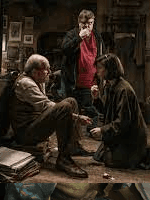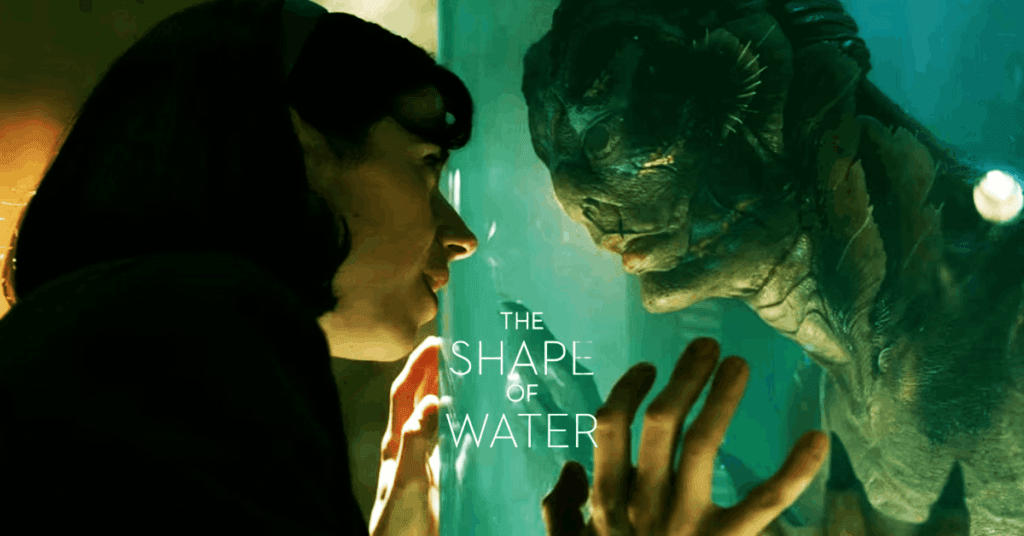Alright, let’s talk about The Shape of Water (2017). Ever had a movie linger in your mind long after the final scene fades away? This is one of them. It’s got romance, fantasy, a bit of Cold War thriller, and a whole lot of heart. But let’s be real—the moment you hear “a mute woman falls in love with a sea creature,” you probably do a double take. But trust me, it’s way more magical than it sounds.
Guillermo del Toro took a story that could’ve been bizarre and turned it into one of the most touching love stories ever put on screen. And that’s exactly why we’re talking about it today.

We’ve got Elisa (Sally Hawkins), a mute woman who works as a cleaning lady in a top-secret government lab. Her life is simple—she boils eggs, listens to music, hangs out with her neighbour Giles (Richard Jenkins), and then does it all again the next day. But one day, the lab brings in a mysterious amphibian creature (played by Doug Jones).

Now, most people would probably freak out, but not Elisa. She’s drawn to him. And the best part? They don’t need words to understand each other. Their connection builds through simple, everyday things—sharing food, playing music, just being there. It’s pure, it’s genuine, and it completely sidesteps the usual Hollywood “love at first sight” clichés.
One thing del Toro does brilliantly is making us root for the “outsiders”. Elisa isn’t just mute—she’s overlooked by almost everyone. Her best friend Giles is an aging, lonely artist struggling with his identity in a world that doesn’t accept gays. Zelda (Octavia Spencer), Elisa’s co-worker, faces racism and sexism on a daily basis. And, of course, the Amphibian Man is literally a captured creature being experimented on.
They’re all misfits, pushed aside by society, which makes their bond all the more powerful. When Elisa sees the creature, she doesn’t see something scary—she sees someone like her. And that’s why this story works so well.

Every great love story needs an obstacle, and boy, does this one have a good one—Richard Strickland (Michael Shannon). This guy is the embodiment of 1960s toxic masculinity. He’s obsessed with power, status, and control. He tortures the creature just to prove he’s in charge. He’s got this pristine, all-American family life, but you can tell he’s barely holding it together. What’s scary about him isn’t just his cruelty—it’s how he represents a world that fears what it doesn’t understand. He’s not just hunting the creature—he’s hunting anything that doesn’t fit into his narrow idea of “normal.”
Okay, here’s where it gets personal for del Toro. When he was a kid, he watched Creature from the Black Lagoon (1954) and felt bad for the monster. Everyone saw it as a terrifying creature, but little Guillermo? He saw a lonely being who just wanted to be loved. And the fact that the monster never got the girl? That just didn’t sit right with him. Fast forward decades later, and he finally gave that misunderstood creature the love story it deserved. And that’s why The Shape of Water feels so special—it’s not just a film, it’s a lifelong dream coming true.
The film’s called The Shape of Water, but that’s not just a cool-sounding name. Water is everywhere in this movie—not just physically, but symbolically. Water takes the shape of whatever holds it, just like love, emotions, and even identity. Elisa feels trapped in her silent world, but in water, she’s free. The creature is dying without it because it’s his home. Even the film’s colors—soaked in blues and greens—make you feel like you’re underwater the whole time. And that final underwater scene? It’s like watching a dream unfold.

We have to talk about how visually stunning this movie is—it’s a masterpiece in every frame. Cinematographer makes the camera move like water—fluid, floating, almost hypnotic. The transitions between scenes are seamless, like waves rolling in and out. Every set detail—whether it’s the lab’s cold, sterile walls or the warm, lived-in feel of Elisa’s apartment—adds to the atmosphere. And then there’s the creature itself.
Now, in a world full of CGI-heavy monsters, del Toro did something amazing—he went practical. Doug Jones (who played creature) wore an actual suit, which made the creature feel real, textured, and alive. That’s why you buy into the romance. If it had been all CGI, it just wouldn’t have had the same magic.
Since Elisa can’t speak, the film relies heavily on music and sound design to tell her story. And Alexandre Desplat’s Oscar-winning score? Absolute perfection. It’s dreamy, whimsical, and somehow makes you feel exactly what Elisa feels. Silence is also used brilliantly—Elisa’s world is quiet and gentle, while Strickland’s world is full of noise and control. That contrast makes her love story even more delicate and beautiful.
This movie didn’t just win hearts—it won big. At the 90th Academy Awards, The Shape of Water took home Best Picture, Best Director for del Toro, Best Original Score, and Best Production Design. That’s four Oscars! And beyond the awards, it cemented del Toro as a true master of storytelling. This wasn’t just another “monster movie”—it was a piece of cinematic art that showed love has no boundaries.
At its core, The Shape of Water is about love in its purest form. It’s about seeing beyond appearances, about connection, about choosing kindness over fear. Del Toro took a wild, risky premise and turned it into something deeply human. It’s a film that sticks with you, that makes you think, that makes you feel.
So, if you haven’t seen it yet, or if it’s been a while, go watch it again. Let it remind you that love isn’t about words, or logic, or even species. Love exists beyond words or logic. And that’s what makes this movie so damn special.
Film Name: The Shape of Water
Director: Guillermo del Toro
Year: 2017
Cast: Sally Hawkins, Doug Jones, Michael Shannon, Richard Jenkins, Octavia Spencer, Michael Stuhlbarg


























